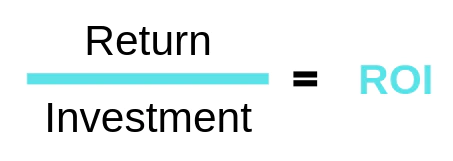How To Calculate ROI For Business – Return On Investment Calculator

Do you own a business? If so, then calculating ROI means Return on Investment is a critical step to perform. Imagine the situation from the entrepreneur’s point of view, you have put your sweat and energy into establishing and running a business, so you obviously would hope for a better return on investment. But is it that easy to calculate? No, calculating ROI is not as straightforward as you think. Don’t worry; here, we will break down the meaning of ROI and how ROI calculator works to calculate for the business, so let’s get started.
[toc]
Return on investment usually refers to ROI, which is one of the critical factors that help you make informed business decisions related to expansion, opportunity, and much more. For any business owner, the main goal is to achieve maximum profitability and make investments that offer attractive yields in the future and allow them to expand their business beyond the horizon.
Small business entrepreneurs usually calculate ROI by dividing net profit by total assets. But it seems vague; you should have a clear picture of your ongoing business operations with an estimated return percentage. If you don’t know where all your money goes and what you are getting, it will hurt your business balance sheet’s in the long run, and you will end up having zero bucks in your treasury.
What is Return on Investment

Source: (Oberlo)
ROI aka, Return on Investment, refers to the financial benefits received from a particular investment. In simple words, ROI is an important metric that helps you know what you will get for what you put in right now.
Whether you are an entrepreneur or an individual making an investment in various schemes, you have the right to ask, “what will I get after this?” Make sure you may get returns in diverse forms, such as in the form of shares, in the form of retirement funding, or in the form of partnership; it may vary but knowing what you will get in return for your inputs is paramount.
Now without any ado, let’s discuss in detail what formula works better to calculate ROI and why it is important for your business.
What is the Return on Investment Formula?
Now you know the meaning of ROI; it measures how effective your investments are in your business to generate a decent income. But here we are talking about the return on investment formula. ROI formula consists of the division of an investment’s profit by its cost.
Let’s understand it with a proper mathematical formula,
Return on Investment= (gain on investment – the cost of investment)/Cost of Investment *100
Here, the current value of investment means the gain obtained from the sale of the investment of interest. Since ROI is usually calculated as a percentage, you can easily compare it with different investment options available. The above formula is quite difficult to understand, so let’s take a relevant example to grasp the concept more quickly.
For instance, you purchased shares for a company five years ago for $1000, and now the market value of those shares is $5000. How would you calculate ROI?
ROI= (Gain on investment – cost of investment/ cost of investment *100)
ROI= ($5000-$1000/$1000*100) =400%
Here your return on investment would be 400%.
This means that your initial return on Investment in XYZ company is positive since you are getting 400% profit on your initial investments.
This is a pretty simple formula that entrepreneurs and investors use to measure the ROI but determining the accurate ROI is a complex process as multiple factors come into the picture, such as time, hidden cost, and emotional factors such as stress.
The above formula is general; if you are an entrepreneur and want to calculate ROI for your business, you need to consider multiple aspects such as debtors, assets, creditors, recurring expenses, etc. This is not enough, right? Let’s understand how to calculate ROI for your business.
ROI Calculator Formula to Calculate for Your Business?
Working capital plays an important role in the smooth running of the business. And ROI calculator formula to calculating for a business is a bit complex as the owner needs to consider multiple factors such as rent, salary expenses, raw material cost, selling prices, and whatnot.
This could be one of the reasons why small business entrepreneurs are unable to calculate ROI. They just pay attention to cash expenses and cash income, and they are content with the equation. But this is not the way to evaluate a business’s performance. Hence, here we will explain to you in detail how to calculate ROI for your business with ease in different scenarios.
Note: The figures and instances are taken for explanation purposes only; it might vary from business to business according to the situation.
Scenario 1
You are operating a small business and want to calculate the return on your investment for the first year. Here you will need to know how many investments and money you have put into date and what are your current debts. You also need to know what your income and profit ratio is after cutting several taxes. You can get all of this information from your account journal or spreadsheets.
For instance, your debt is $15,000, and your business owner’s equity is $45000. Now the addition of both amounts would be $60,000. Whereas your total net income after deduction of taxes is $1,35,000. Now let’s go through how to put this amount in the equation and what the actual ROI of your business is.
ROI= $1,35,000/$60,000*100= 225 %
Here’s the ROI for your business is 225%, which is quite high. However, this will change from year to year because income, expenses, debts, raw material costs, and other fixed expenses keep evolving with time.
Scenario 2
You are occupied with an eCommerce business and want to redesign your website. The total cost of investment is $ 15,0000, which includes web designing fees, hosting fees, and an HD photoshoot for your entire product line.
After the first month of website redesigning, your eCommerce store generated a net profit of $3000. Well, this net profit comes after deducting all expenses such as product procurement, product shipping, handling cost, and other miscellaneous costs associated with your online store.
Now, what would be the ROI of your eCommerce store? Let’s calculate it.
ROI of your online store = net profit/cost*100
ROI=$3000/$15000*100= 20%
Return on investment for your eCommerce store is 20% which is decent.
What is Good ROI?
In the above scenarios, the return on investment is positive, which can be considered a good return on investment. If you want to “level up” your business to have phenomenal growth, you will need to get started with emerging technology solutions and digital marketing techniques. And make sure you are responding to customer reviews as that can help you enhance your local rankings, Google says that.
Why Calculating ROI for Your Business Is Crucial?
Running a business without having a clear picture of your profitability seems like you keep moving without any motive or objective. Having the foresight to determine if an executed action will result in a positive return allows you to make informed business decisions that will eventually reap you exclusive benefits in the long run.
Along with the decision-making process, here are few added benefits of calculating ROI:
- Showcase your business’s strengths and weakness
- Forecast financial growth of your company
- Track business progress
- Helps to address pinpoints of business
Calculating ROI for your business also comes in handy. It can give you a clear insight into different investments and campaigns; you will also come to know what investment or campaign drives profitability and contribute a major share in business growth.
Indeed, the above formulas and concepts are useful to measure business performance, but patience and discipline with the investment are something that pays off in the long run.
